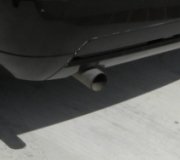Hi frankie350. A good place to start is by having any stored diagnostic fault codes read. Auto Zone will do that for you, but their equipment will not read live sensor data. If the Engine Computer detected a problem that could adversely affect tail pipe emissions, it will turn on the Check Engine light as well as store a code. You will get more information from a mechanic with a hand-held computer, called a scanner, that can read sensor information. In particular, the MAP sensor should be looked at closely. He has the biggest say in how much fuel is commanded to enter the engine.
The MAP sensor puts out a signal between.5 an 4.5 volts. When something causes the voltage to fall outside that range, the computer detects it as a fault and sets the appropriate code in memory. However, as long as the voltage is within that range, the computer will believe it, even though it could be wrong. Usually this type of failure takes less than a few days to become bad enough to be detected by the computer. Look too for a loose or dry-rotted vacuum hose. Since the MAP sensor detects and is extremely sensitive to tiny changes in manifold vacuum, a leaking hose will affect its readings.
Two other, but less common things to look for are low fuel pressure and a bad spot in the throttle position sensor. If you remove the vacuum hose from the fuel pressure regulator and plug it, and the problem goes away, suspect a pressure-related problem although this is very rare on Chrysler products. Unplugging the hose at the regulator will cause pressure to go way up, so expect to see some black smoke from the tail pipe. The higher than normal pressure will force too much fuel through the injectors so the mixture will be too rich.
Besides position, the throttle position sensor tells the Engine Computer direction of movement and rate of movement of the gas pedal. Lack of this information can cause a lag in the computer's response in how long it commands the fuel injectors to open. This problem will normally not be related to engine temperature but it is often intermittent.
Backfiring was a fairly common problem years ago with the 3.3L engines in the front-wheel-drive cars and minivans. It was caused by the original spark plug wires. I haven't heard of that on full-size vans, but it's worth mentioning. If none of these ideas lead to a solution, have your mechanic connect his scanner and take it on a test drive when the engine is still cold. The live sensor data should provide some valuable clues.
Caradiodoc
SPONSORED LINKS
Sunday, April 4th, 2010 AT 2:43 PM




